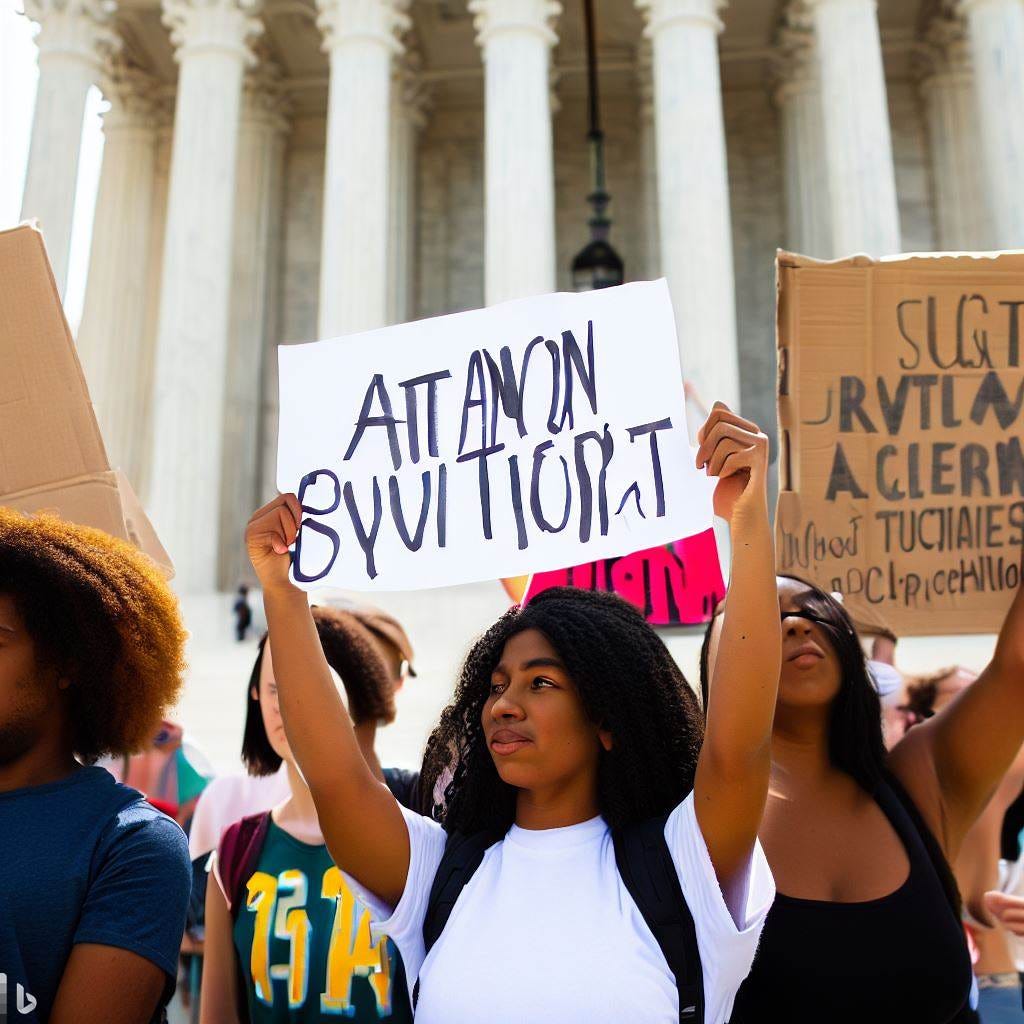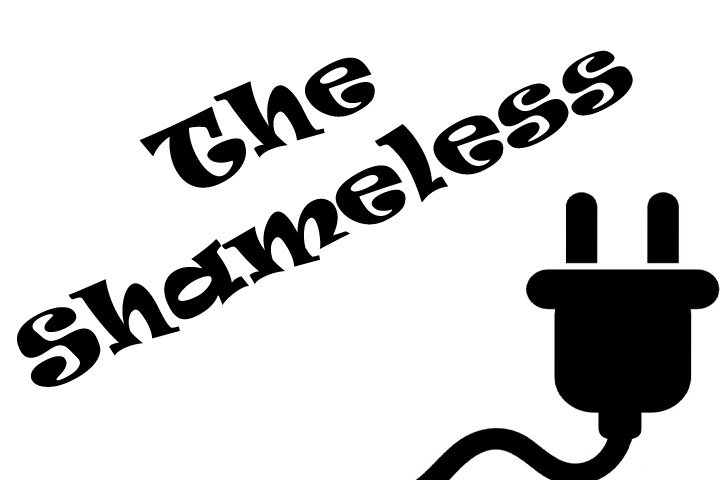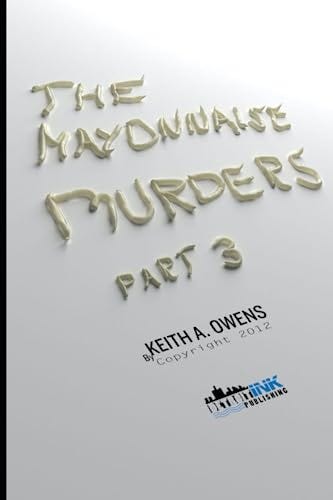When protesters demonstrated against the ending of affirmative action, this is what the Supreme Court majority saw: a bunch of gibberish that needed to be erased.
Issue #360 OpEd July 10, 2023
You’ll note that in much of the media coverage concerning the Supreme Court’s recent 6-3 decision on June 29, 2023, to end the use of affirmative action by colleges and universities as part of their admissions process, there wasn’t much surprise about the decision. No one was shocked, and pretty much everyone was expecting this to happen.
Sure, a large part of the reason why this decision was predictable is because of the current makeup of the court; it is the Dream Team of Justice Clarence Thomas who, rather than Justice John Roberts, is beginning to be regarded as the true leverage point on the court.
“We Are Speaking,” which we publish seven days a week, is financially supported by our paid subscribers and by your investments in the products and services offered by the Global Creative Community Branding and Marketing Academy. Please make sure to view and act on the important information at the end of this article to help support and grow “We Are Speaking.” Thank you!
But I think a much bigger reason for the court’s decision, and why it was inevitable, is that a lot of white folks are tired of affirmative action, plain and simple. Whites overall weren’t that thrilled with affirmative action when it first became law, but they tolerated it. They tolerated it because there seemed to be a general understanding across the country that something had to be done to address racial grievances. And so within a matter of years, President Lyndon Johnson pushed the Civil Rights Act (the version with some teeth passed in 1968), and the Voting Rights Act (passed in 1965) across the finish line.
But first, President John F. Kennedy started the ball rolling in 1961 with Executive Order 10925, which reads as follows (from the University of California Irvine):
Executive Order 10925
On March 6, 1961 President John F. Kennedy issued Executive Order 10925, which included a provision that government contractors "take affirmative action to ensure that applicants are employed, and employees are treated during employment, without regard to their race, creed, color, or national origin." The intent of this executive order was to affirm the government's commitment to equal opportunity for all qualified persons, and to take positive action to strengthen efforts to realize true equal opportunity for all. This executive order was superseded by Executive Order 11246 in 1965.
Executive Order 11246, reads as follows:
Executive Order 11246
On September 24, 1965 President Lyndon B. Johnson issued Executive Order 11246, prohibiting employment discrimination based on race, color, religion, and national origin by those organizations receiving federal contracts and subcontracts. In 1967, President Johnson amended the order to include sex on the list of attributes. Executive Order 11246 also requires federal contractors to take affirmative action to promote the full realization of equal opportunity for women and minorities. The Office of Federal Contract Compliance Programs (OFCCP), under the Department of Labor, monitors this requirement for all federal contractors, including all UC campuses, and has developed regulations to which these contractors must adhere. For federal contractors employing more than 50 people and having federal contracts totaling more than $50,000, compliance with these regulations includes disseminating and enforcing a nondiscrimination policy, establishing a written affirmative action plan and placement goals for women and minorities, and implementing action-oriented programs for accomplishing these goals. In addition, an official of the organization must be assigned responsibility for implementation of equal employment opportunity and the affirmative action program.
An excerpt from the executive order follows (Part II, Subpart B, Sec. 202(1)):
The contractor will not discriminate against any employee or applicant for employment because of race, color, religion, sex, or national origin. The contractor will take affirmative action to ensure that applicants are employed, and that employees are treated during employment, without regard to their race, color, religion, sex or national origin. Such action shall include, but not be limited to the following: employment, upgrading, demotion, or transfer; recruitment or recruitment advertising; layoff or termination; rates of pay or other forms of compensation; and selection for training, including apprenticeship.
But then, exactly 30 years later in 1995, white folks in California figured they’d had enough of leveling the playing field - a playing field that had been tilted dramatically in favor of white everything for nearly four centuries while stepping on the necks of Black and brown people - and decided it was time for America to get back to the business of being America. To wit:
On July 20, 1995 the Board of Regents of the University of California adopted Regents Resolutions SP-1 and SP-2. In effect, SP-1 required that race, religion, sex, color, ethnicity, and national origin not be considered in the admissions decision process. SP-2 focused on University employment and contracts, eliminating consideration of the same attributes in hiring and contracting decisions. Both resolutions stipulated that nothing contained within these sections should be interpreted to prohibit any action strictly necessary to maintain or establish eligibility to receive federal or state funding. To that end, the requirements set forth under Executive Order 11246 still applied to UC campuses. The relevant sections are as follows:
SP-1, Section 2:
Effective January 1, 1997, the University of California shall not use race, religion, sex, color, ethnicity, or national origin as criteria for admission to the University or to any program of study.
SP-2, Section 1:
Effective January 1, 1996, the University of California shall not use race, religion, sex, color, ethnicity, or national origin as criteria in its employment and contracting practices.
And today, just two years short of what will be the passage of yet another three decades come 2025, the Supreme Court has followed the lead of the University of California, ending the use of affirmative action for college and university admissions. Because to continue the use of affirmative action would be to continue to acknowledge the rather understandable fact that within the span of roughly 60 years, America hasn’t managed to sufficiently address the devastating effects of nearly 400 years of oppression since the first slave ship landed on these shores in 1619. And so we might as well give up on what’s right because white people are getting tired. Justice takes too damned long.
So much easier to follow the lead of Florida Gov. Rick DeSantis and simply erase Black history altogether. That way, if nobody knows anything was ever wrong, there’s nothing for white people to apologize for! Problem solved!
America. What’s not to love? Right?
Let us know your thoughts about what new information you learned in the comments or in the Substack Notes feature.
You can always leave any questions in the comments or email us.
You can also receive up to six months of a paid subscription for referring people to us with the Share Button or the Refer Button.
This article is free to access for 1 week after publication. Please consider becoming a paid subscriber for $5/month or less to access all of the articles and other benefits.
This is your chance to support everything Keith and Pam do. We appreciate you!
Purchase and download your copy of the “Branding And Marketing For The Rest Of Us” eBook for Independent Authors and Creative and Solo Professionals and other valuable eBooks.
Enroll in one of the 6-course bundles designed especially for you: “Author and Book Marketing” and/or “Essential Creative Marketing.”
Purchase your copies of “Detroit Stories Quarterly” issues.
Purchase your copies of “The Mayonnaise Murders” Parts 1, 2, and 3
What else do Keith and Pam do?
Where else can you find us?
Click the link below to learn everything you need to know and review everything we offer for independent writers and creative and solo professionals.









